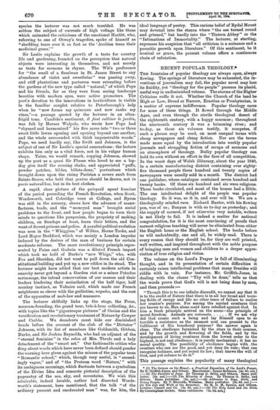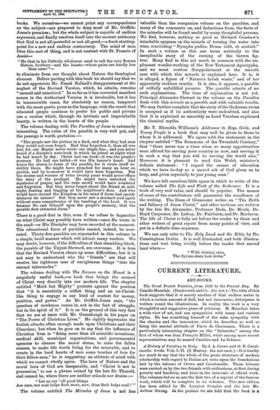books. We ourselves—we cannot print any correspondence on the subject—are
prepared to deny most of Mr. Griffith- Jones's premises ; but the whole subject is capable of endless argument, and finally resolves itself into the ancient antinomy that God is not all-powerful or not all-good,—a fresh starting. point for a new and endless controversy. The mind of man likes this sort of thing, and is not content with St. Francis of Assisi- " He that in his Catholic wholeness used to call the very flowers Sisters, brothers—and the beasts—whose pains are hardly less than ours I”—
to eliminate from our thought about Nature the theological element. Before parting with this book we should say that we do not appreciate Mr. Frank Ballard's disappointment at the neglect of the Revised Version, which, he admits, remains "unused and unnoticed." I.n so far as it has corrected manifest errors in the Authorised Version it is invaluable, but it has in innumerable cases, for absolutely no reason, tampered with the most poetic prose in the language, with the result that educated people continue to prefer for public and private use a version which, through its intrinsic and imperishable beauty, is written in the hearts of the people.
The volume dealing with The Parables of Jesus is extremely interesting. The value of the parable is very well put, and the passage is worth quotation
" The people saw the picture in a flash, and what they had seen they would not soon forget. Had they forgotten it, then all was lost, for our Master never wrote one single line ; and you never heard of a disciple's note-book in which he jotted at night what he had heard by day. Christ had one book—it was the people's memory. He had one tablet—it was His hearer's heart. And hence the charm to Jesus of the parable, for it wrote itself in- delibly there. He might have preached for many an hour on pardon, and by to-morrow it would have been forgotten. But the storms and worries of twice twenty years would never efface the story of the prodigal. He might have unlocked the mysteries of prayer, and the rude crowd would have wondered and forgotten. But they never forgot about the friend at mid- night, beating and begging at his neighbour's door. And who would have carried the Kingdom in his mind if Jesus had openly declared its nature? But they never saw a mustard seed again without some remembrance of the teaching of the Lord. It was because He cast Himself upon the people's memory, that the parable first attracted Jesus."
There is a good deal in this, even if we refuse to dogmatise on what Christ may possibly have written—once He wrote in the sand—or His Disciples may have recorded at the moment. The educational force of parables cannot, indeed, be over- rated. Thirty-five parables are expounded in this volume in a simple, lucid manner which will attract many readers. We may doubt, however, if the difficulties of that stumbling-block, the parable of the Unjust Steward, are overcome. It is true that the Revised 'Version clears up some difficulties; but it is not easy to understand who the "friends" are that will receive the righteous user of unrighteous things "into the eternal tabernacles."
The volume dealing with The Sermon on the Mount is a singularly useful book,—a book that brings the counsel of Christ very directly into our modern life. The chapter entitled "Meek but Mighty" protests against the position that "it is essentially a selfish thing and an un-Christ- like thing to engage in any kind of contest for money, position, and power." As Mr. Griffith-Jones says, "the question of meekness comes in, not in the fact of struggle, but in the spirit of it." It is on the ground of this very fact that we are at issue with Mr. Greenhough in his paper on "The Power of Christian Lives." He rightly deprecates the foolish attacks often enough made upon Christians and their Churches; but when he goes on to say that the influence of Christian lives is" doing more than all scientific inventions, medical skill, municipal organisations, and governmental agencies to cleanse the moral slums, to raise the fallen masses, to make life worth living for the miserable, and to create in the hard hearts of men some touches of love for their fellow-men," he in suggesting an attitude of mind with which we cannot wholly agree. The laws of Nature and the moral laws of God are inseparable, and "Christ is not in possession," to use a phrase coined by the late Dr. Thorold, and cannot be, where there are neither schools nor drains :— " Let us cry 'all good things Are ours, nor soul helps flesh more, now, than flesh helps soul !"
The volume entitled The Miracles of Jesus is not less Mr. T. Rhondda Williams's Addresses to Boys, Girls, and Young People is a book that may well be given to those to whom it is addressed. We agree with the statement, in the chapter entitled "The Summons of the Twentieth Century," that "there never was a 'time when so many opportunities were offered for serving your country as now, and serving it in such a way that you will be serving the world also." Moreover, it is pleasant to read this Welsh minister's definite statement; "I regard the means of education which we have to-day as a sacred ark of God given us to keep, and given especially to you young men."
We have left ourselves little space in which to write of the volume called The Life and Work of the Redeemer. It is a work of very real value, and should be popular. The names of some of the contributors will guarantee the excellence of the writing. The Dean of Gloucester writes on "The Birth and Infancy of Jesus Christ," and other sections are written by the late Dr. Alexander, Professor Dods, Dr, Motile, Dr. Boyd Carpenter, Dr. Lefroy, Dr. Fairbairn, and Dr. Maclaren. The life of Christ is fully set before the reader by these and other writers of great repute from many points of view, and yet in a definite time sequence.
We can only refer to The Holy Land and the Bible, by Dr. Cunningham Geikie. It is well illustrated, and both illustra- tions and text bring vividly before the reader that sacred land where- The Syrian stars look down."
C CEMENT LITEB,AT CTR,E.
ART-BOOKS.
The Great French Painters,frone 1830 to the Present Day. By Camille Mauclair. (Duckworth and Co. file. net.)—The title of this book suggests that it is merely another of that endless series in which a certain amount of dull, but not inaccurate, letterpress is written round the illustrations. In reality the work is a very thoughtful and suggestive piece of criticism. H. Mauclair takes s wide view of art, and can sympathise with many and various styles. He has something himself of the calm sympathy with the classics and the innovators which he describes so well as being the mental attitude of Pavia de Cheyennes. There is a particularly interesting chapter on the " Intimists" among the first of whom was Jean Francois Millet, while among more recent representatives may be named Carrara and he Sidemen A History of Painting in Italy. By J. A. Crowe and G. B. Caval. easelle. 6 vols. Vols. I:IL (J. Murray. 21e. net each.)—It is hardly too much to say that the whole of the great structure of modern scholarship with regard to Italian art rests upon the foundations laid by the labours of Crowe and Cavalcaselle. These labours were carried on by the two friends with enthusiasm, at first during poverty and hardship, and later in the intervals of official work. The volumes before us are the first two of a reprint of the famous work, which will be complete in six volumes. This new edition has been edited by Mr. Langton Douglas and the late Mr. Arthur Strong. In the preface we are told that the book is a
" With shining eyes,























































 Previous page
Previous page